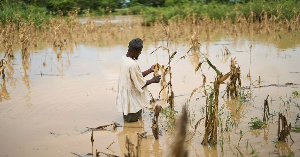General News of Monday, 8 May 2006
Source: Public Agenda
1.41 Million Children Are Full Time Workers in Ghana
Results from the Ghana National Child Labour Survey conducted indicate that 0.75 million or 27.6 percent of males from 5-14 years work and 0.66 million or 26.3 percent of females of the same age group work, resulting in 1.41 million or 27 percent of all children of 5 to 14 working.
The trend (more children working) is the same in almost all Africa countries, where some 50,000 children are in prostitution and pornography. In addition some, 120,000 children under 18 years are reported to have been coerced into taking up arms as child soldiers. These statistics were contained in a new report on child labour issued by the International Labour Organisation (ILO) and researched by the International Programme on the Elimination of Child Labour (IPEC). Ghana featured prominently in the report titled, 'The End of Child Labour', which spells out steps countries should take to eliminate child labour. A specific example is given of how Malaysia, poorer than Ghana at independence in 1957 took off economically in the 1960s and virtually eradicated poverty and achieved universal education. Though Ghana is listed as one of 42 African countries to have ratified the ILO convention on child labour, child labour is pervasive in many communities.On the global scale, ILO estimates that more than 104 million children are currently without primary schooling, of whom 56 percent are girls. South and East Asia account for almost half of these children although, if current trends continue by 2015 more than half of the out-of-school children will be African. In addition, an estimated 130 million children do not attend school regularly because of work commitments, more than half coming from Africa. The World Bank officially recognizes child labour as one of the most devastating aspects of persistent poverty. The foremost reason according to the report is that one-six of people living in Sub Saharan Africa are chronically poor, and this poverty has been worsening. The ILO estimates that the number of poor people is expected to rise 315 million in 1999 to 401 million by 2015. "Africa is the only continent where the proportion of the population is growing", says the ILO report. An on going study on bonded child labour in Ghana, Haiti, Niger and Pakistan aims to gather evidence on the link between child labour and poverty. Special emphasis has been placed on domestic service and agriculture. Another research being undertaken by IPEC is trying to identify particular occupations in which child labour is especially profitable and how this can be stopped. Large businesses in particular came under pressure in 1990s to pay greater attention to the impact that their activities on human rights of the work force, especially children. In education, the picture is a bit more encouraging with more children enrolling in schools. In Malawi and Uganda, enrollment doubled between 1995 and 2000. But 47 million African children are still out of school and of those who start primary education, only one in three finishes. In Ghana, enrollment has just started to go up, thanks to the government's capitation grant policy introduced last year. But increased enrollment has only exposed the country's weak educational infrastructure. Can children be their own watchdogs? There is growing consensus that children should be viewed as active partners in the worldwide movement. The first global report on child labour says the impetus for children as active participants stems from the Convention on the Rights of Children. The question then is, how can children police themselves? This is where the consensus breaks down among stakeholders. Much of the pressure to abolish child labour, particularly, its worst forms has come from the international community rather than from domestic sources, argues the report, though in Ghana the Trades Union Congress and some NGOs have done a lot of work in this area.
Though there are now more actors and activities at all levels of the movement, from local to global, there is need to take several steps towards revitalizing and strengthening the worldwide movement against child labour. The ILO's first step is to engage governments more forcefully in a commitment to its elimination.












